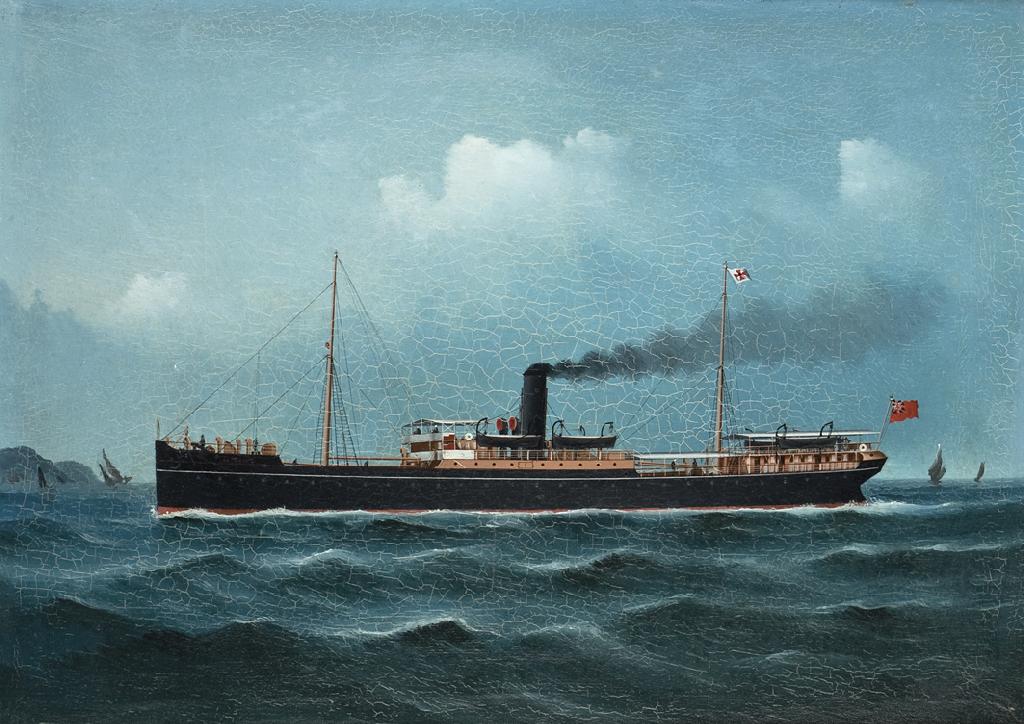Douglas Steamship Company, Ltd., Hong Kong, 1883-1976
 |
| Douglas Lapraik |
Douglas Lapraik (1818-1869) who started his Hong
Kong career as a watchmaker's apprentice, in 1860 founded a
steamship company which ran the south China coast. By the time of
his death in 1869 Douglas Lapraik owned seven steamships.
In 1866, Douglas Lapraik(1) together with Thomas
Sutherland, also founded the well-known Hong Kong and Whampoa Dock
Company, which is at the present day one of the largest concerns of
the kind in the world. They built docks under arrangements with the
Admiralty to admit the largest ships in the Navy, thus creating in
Hong Kong an effective naval base.
In 1866 Douglas Lapraik retired from his company and his nephew
J.S. Lapraik took over as a director. J.S. Lapraik took two partners
and continued the company as Douglas Lapraik & Co.
The Douglas Steamship Company was formed 1883 and took over
the various steamers and other assets which had been managed but
only partly owned by the firm of Douglas Lapraik & Co. J.S. Lapraik
died in 1893 and the firm was lead by junior partner Davis.
The cession of Taiwan to Japan under the Treaty of Shimonoseki in
1895 which ended the Sino-Japanese War, struck the company a heavy
blow.
Osaka Shosen Kaisha (OSK)
placed several steamers on the Amoy Tansui Line and the Douglas
Steamship Company was forced to cut down freight rates. Also, OSK
opened several other lines and began to compete on the China coast
with Douglas Steamship Company and the company incurred severe
losses.
Fortunately, in 1900 and 1901, satisfactory earnings were made by
chartering several ships to the British Government and later to the
American Government due to the Boxer uprising in China. The Taiwan
trade was a lost cause and the company withdrew from it.
The Company would maintain its position on the China coast,
but in the late 1920s the company had run into financial
difficulties and in 1932, S.T. Williamson bought a controlling
interest in the Douglas Steamship Company.
The outbreak of open warfare between China and Japan in 1937 was
nearly the end of shipping around the China coast and the company
started trading between Hong Kong and the Treaty Ports. Also the
ships were redeployed, as well as was possible.
When Japan attacked Pearl Harbour the ships were taken over
by the Hong Kong Shipping Board for the Ministry Of War Transport
(MOWT) service. When Japan seized Hong Kong all the staff were
interned on Christmas Day 1941.
At the end of World War II the company tried to regain its
old trade but when S.T. Williamson died in 1950, J.R. Mullion became
Chairman of the Douglas Steamship Company and the remaining two
ships were sold and the company became an investment company.
In the mid 1950s Mullion decided to reinvest in shipping
again and the Douglas Steamship Company bought three Empire ships
followed in 1959 with a similar ship. In 1966 Mullion & Co. formally
took over as managers.
In 1969-1970 the Empire ships were replaced by other tonnage
among them two tankers.
The Mullion Group decided to sell of its
ships in the mid 1970s and the Douglas Steamship Company was
formally wind up in 1976.
|
Chinese School (c.1900) Port
side profile of the Douglas & Co. cargo ship S.S. Haiching
steaming in calm waters off a headland with shipping beyond.
12 x 17in. (30.5 x 43cm.) Framed. Provenance: Sotheby's
Olympia 18/6/03, lot 55. Built in 1898 by Dunlop & Co.,
Glasgow, Haiching registered 2,182 gross. In 1929 she was
seized by pirates enroute to Swatow, set afire and gutted
amidships, she was saved by H.M.S. Shirley who escorted her
back to Hong Kong for repairs. She was torpedoed and sunk by
U-168 100 miles west of Bombay on 2nd October 1943. £300-500 |
 |
Naturally, wealth drove Douglas into improving his
accommodation and he thought about building a house of his
own. In 1860, the Government had decided to build a
reservoir in Pokfulam, a valley in the south side of Hong
Kong Island. To be coupled with miles of conduit pipes, the
reservoir was thought to be the answer to the water supply
problem. He set his eyes on the hill by the entrance to the
road to the reservoir under construction. The hill commanded
panoramic views, not to mention close proximity to water
supply. The road to the land began in Sai Wan, the Western
District of today, and led to Aberdeen, where Douglas was
planning to set up his docks. In about 1861, he obtained a
75 years lease from the Government for the hill and set
about building on its top a small castle. Known as Rural
Building Lot 32, the land had a registered site area of
310,227 square feet.
When completed, probably in
1864, it was a compound composed of a single-storey house
featuring an octagonal penthouse bedroom that commanded
excellent 360∘hill and sea views, with an octagonal side
house and a rectangular outhouse. As Douglas was only a
single man in his mid-40s whose love and hobby lied in his
numerous business ventures, Douglas Castle provided him very
comfortable accommodation. However, he did not spend much,
if any, time in Douglas Castle. |
 |
Notes:
1. Douglas Lapraik's father, George Rankine
Lapraik, 1783-1838, married Susan Black b1790 in St George Hanover
Square, London, as were many members of the Douglas family. Where
the family link is, i have yet to discover.
See also:
• Douglas
Castle, Hong Kong


